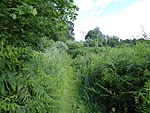Tranmer House
1938 archaeological discoveries1939 archaeological discoveriesAnglo-Saxon artArchaeological museums in EnglandArchaeological sites in Suffolk ... and 5 more
Country houses in SuffolkNational Trust properties in SuffolkSutton, SuffolkSutton HooUse British English from January 2021

Tranmer House is a country house in Sutton Hoo, Woodbridge, Suffolk, England, dating from 1910. The house is located on the Sutton Hoo Anglo-Saxon burial site, and in 1938 was the home of Edith Pretty. In June 1938, Pretty employed Basil Brown to undertake the excavation of a range of burial mounds on the estate, leading to Brown's discovery in May 1939 of a ship burial, "one of the most important archaeological discoveries of all time". The house is now owned by the National Trust.
Excerpt from the Wikipedia article Tranmer House (License: CC BY-SA 3.0, Authors, Images).Tranmer House
Haddon Approach, East Suffolk
Geographical coordinates (GPS) Address Nearby Places Show on map
Geographical coordinates (GPS)
| Latitude | Longitude |
|---|---|
| N 52.0908 ° | E 1.3381 ° |
Address
Sutton Hoo Archeological Site
Haddon Approach
IP12 3DN East Suffolk
England, United Kingdom
Open on Google Maps











